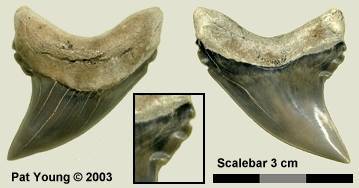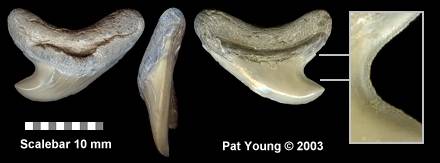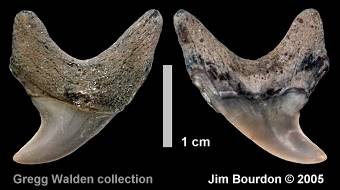Two thresher sharks are found in the mine. Both come from the Pungo River
formation and although uncommon, dedicated searching should turn up
one or two. Fine screening of the waste tailings will usually turn up several
small specimens. In addition, tailings very rarely yield teeth that have been
ascribed to Alopias grandis (LERICHE, 1942).
"Alopias grandis" (LERICHE, 1942)
Teeth of this design have been previously reported as a rare component of
Chesapeake Bay sediments. These teeth get much larger than those of other
Alopias species - the figure 3 specimen measures 4.7 cm diagonally. They are
best characterized by their alopiid-look, large size and articulated shoulders.
(Specimens from the Chesapeake often have incipient serrations, refer to figure 4, a Lee Creek tooth.)
Insufficient examples have been found or documented to speculate upon the dentition
design. However, the authors have seen teeth with these characteristics from upper
lateral & posterior and lower file positions.
There remains the question as to whether or not these teeth are even alopiid. Kent
(1994) argued that they more likely represented upper laterals of "Isurus" hastalis.
He noted the more angular root, weak labial overhang and the presence of a similar
tooth in an associated hastalis dentition.
These authors are not arguing for or against the proper genus. These specimens are being
presented as rare tooth-designs found in both Pungo River and Yorktown sediments
of North Carolina. Purdy et al (2001) did not include this tooth design in the fauna.
 |
Fig. 3 - "A. grandis"
Note ginzu-like shoulder design. Yorktown specimen. |
 |
Fig. 4 - "A. grandis"
Note incipient serration. Lee Creek specimen. |
 |
Fig. 5 - "A. grandis"
Lee Creek specimen. |